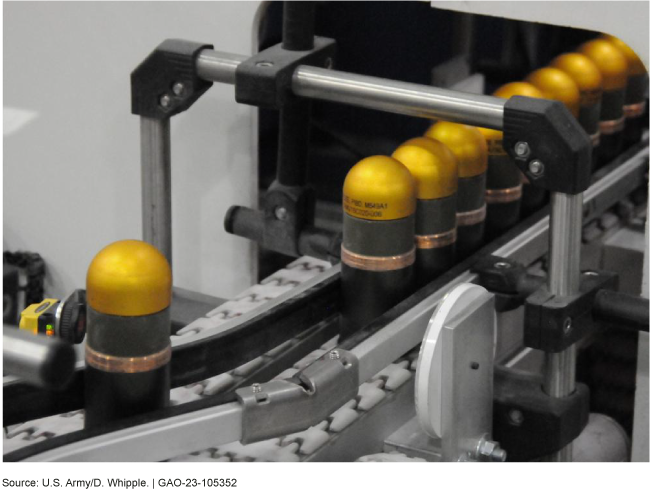Army Ammunition: Actions Needed to Improve Management of Procurement and Production Practices
Fast Facts
The Army procures and produces certain types of ammunition (like artillery shells and mortar rounds) for all the military services. Army officials at headquarters and production plants are responsible for managing this effort.
However, many of these officials lack clarity about their roles and responsibilities because the Army's governing documents are outdated. This hinders effective decision-making—such as when poor coordination between officials resulted in the Army purchasing a $2.8 million piece of equipment that can't perform its intended function.
We recommended (among other things) that the Army revise its governing documents.
Production of 40 Caliber Grenades at an Army Ammunition Plant

Highlights
What GAO Found
The Army manages the procurement and production of ammunition—such as small arms cartridges, rockets, artillery shells, and mortars—at government-owned, contractor-operated plants. Doing so involves overseeing complex relationships—such as intersecting roles and responsibilities—among multiple Army organizations at both the headquarters and plant levels.
Army Organizations Involved in Ammunition Procurement and Production, and Their Intersecting Areas of Responsibility

The Army has not revised governing documents to reflect changes over time. For example:
- The agreement that lays out the responsibilities of two Army organizations—Joint Munitions Command, and Joint Program Executive Office Armaments and Ammunition—has not been revised since 2004 even though the roles, responsibilities, and authorities have often changed.
- Governing documents do not reflect the role or operating procedures of the recently established Army Futures Command, nor do they outline the relationships between Army Contracting Command and other Army organizations.
- Officials from some Army organizations told GAO that, due in part to this outdated documentation, they lack clarity about the roles and responsibilities of the multiple organizations responsible for managing ammunition plants. Army officials indicated that the governing documentation should be revised to clarify roles and responsibilities. Previous attempts to do so stalled, however, as all relevant parties have not yet been able to come to an agreement.
Why GAO Did This Study
The Army is responsible for procuring and producing certain types of ammunition for all the military services. The Army procures most of this ammunition from five government-owned, contractor-operated plants, which, according to the Army, reduces its role in the production process to one of management. The Army also retains a significant capacity for ammunition production that can withstand fluctuations in demand.
GAO was asked to review the Army's current practices for managing the procurement and production of ammunition. This report addresses the Army's relationships and challenges related to government-owned, contractor-operated ammunition plants, among other issues. GAO reviewed and analyzed relevant statutes, regulations, documents, and contracts; and interviewed Army and vendor officials.
Recommendations
GAO is making two recommendations to the Army, including that it revise the documents governing management of the procurement and production of ammunition at government-owned, contractor-operated plants to clarify roles and responsibilities. The Army concurred with both of the recommendations.
Recommendations for Executive Action
| Agency Affected Sort descending | Recommendation | Status |
|---|---|---|
| Department of the Army | The Secretary of the Army should direct the appropriate offices within the Army to revise the governing documents of Army organizations involved in managing the procurement and production of conventional ammunition at government-owned, contractor-operated plants to ensure they are current and clearly delineate roles and responsibilities. (Recommendation 1) |
Open
DOD concurred with the recommendation. In October 2022, Army officials described the corrective actions being taken to implement the recommendation. This includes updating the governing documents GAO identified in the report to clearly define the authorities, roles, and responsibilities associated with managing the procurement and production of ammunition at the government-owned, contractor-operated Army ammunition plants. Officials estimate that they will complete these actions in December 2023.
|
| Department of the Army | The Secretary of the Army should ensure the Assistant Secretary of the Army for Acquisition, Logistics, and Technology directs the Joint Program Executive Office Armaments and Ammunition, in conjunction with Joint Munitions Command and Army Contracting Command, to establish a mechanism to collect, analyze, validate, archive, and share lessons learned related to managing conventional ammunition procurement and production at government-owned, contractor-operated plants. (Recommendation 2) |
Open
DOD concurred with the recommendation. In October 2022, Army officials stated that they are developing a mechanism to collect, analyze, validate, store, archive, disseminate, and share lessons learned associated with managing the government-owned, contractor-operated Army ammunition plants. Lessons learned will be captured from government-owned, contractor-operated competitions, contracting, Performance Work Statement execution, modernization, and production. Officials estimate that they will complete these actions in December 2023.
|
